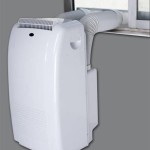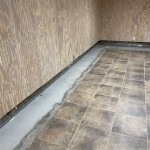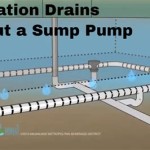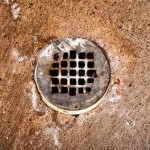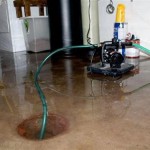How a Basement Floor Drain Works
A basement floor drain is an essential component in many homes, particularly those located in areas prone to flooding or with high water tables. Its primary function is to remove excess water from the basement, preventing water damage and the growth of mold and mildew. Understanding how a basement floor drain works is crucial for maintaining a healthy and dry living environment. This article will delve into the mechanisms of a basement floor drain, its different types, maintenance requirements, and potential problems.
The basic concept behind a basement floor drain's operation is quite simple: gravity. Water naturally flows downwards, and the floor drain provides a low point in the basement where water can accumulate and then drain away. The drain is typically located in the lowest part of the basement floor, where water is most likely to collect. The drain itself is connected to a network of pipes that lead either to the municipal sewer system, a septic tank, or in some cases, a sump pit.
The design of a basement floor drain incorporates several key features that contribute to its effectiveness. These features include a grate or strainer, a drain body, a water trap (also known as a P-trap), and the drain pipe. Each of these components plays a specific role in the overall function of the drain.
The grate or strainer is the visible part of the floor drain, typically a metal or plastic grid that sits flush with the floor. Its primary purpose is to prevent large debris, such as leaves, dirt, and other solid materials, from entering the drain pipe and causing blockages. The openings in the grate are sized to allow water to flow freely while effectively filtering out larger particles. Regular cleaning of the grate is essential to ensure that the drain can adequately remove water.
Beneath the grate is the drain body, which is the main housing of the drain. This is where the water accumulates before entering the drain pipe. The drain body is typically made of cast iron, PVC, or other durable materials that can withstand constant exposure to water and potential chemicals. The design of the drain body is crucial for efficient water flow and preventing backflow.
The water trap, or P-trap, is a U-shaped section of pipe located beneath the drain body. This component is crucial for preventing sewer gases from entering the basement. The P-trap always holds a small amount of water, which acts as a seal, blocking the passage of noxious and potentially dangerous gases from the sewer system. Without a P-trap, the basement would be filled with unpleasant odors and potentially harmful gases like methane and hydrogen sulfide.
The drain pipe is the conduit through which water flows away from the basement. This pipe is typically made of PVC, cast iron, or other durable materials and is connected to the sewer system, septic tank, or sump pit. The drain pipe's diameter and slope are critical for ensuring adequate water flow and preventing clogs. A properly sized and installed drain pipe is essential for the effective operation of the basement floor drain.
The Function of the P-Trap in Preventing Sewer Gases
As mentioned earlier, the P-trap is a critical component of the basement floor drain system. Its primary function is to create a water seal that prevents sewer gases from entering the building. Sewer gases are produced by the decomposition of organic matter in the sewer system and can contain methane, hydrogen sulfide, ammonia, and other potentially harmful substances. These gases can be unpleasant to smell and, in high concentrations, can even be dangerous to human health.
The P-trap works by holding a small amount of water in the U-shaped bend of the pipe. This water acts as a barrier, preventing the gases from rising up through the drain and into the basement. When water flows down the drain, it pushes the existing water in the P-trap out of the way, allowing the waste water to flow into the drain pipe. However, a small amount of water always remains in the P-trap, maintaining the seal.
If a basement floor drain is not used regularly, the water in the P-trap can evaporate over time, breaking the seal and allowing sewer gases to enter the basement. This is a common problem in infrequently used basements or during dry periods. To prevent this, it is recommended to periodically pour water down the drain to replenish the water in the P-trap and maintain the seal.
In some cases, the P-trap may still allow sewer gases to enter the basement even if it is properly filled with water. This can happen if the drain pipe is not properly vented. A vent pipe allows air to enter the drain system, preventing a vacuum from forming that could siphon water out of the P-trap. If the vent pipe is blocked or improperly installed, the P-trap may not function correctly, leading to sewer gas issues.
Types of Basement Floor Drains and Their Applications
While the basic principle of operation remains the same, there are several different types of basement floor drains available, each designed for specific applications and conditions. The choice of drain type depends on factors such as the flow rate requirements, the type of flooring material, and the connection to the drainage system.
One common type is the standard round floor drain, which features a circular grate and a simple drain body. These drains are typically used in residential basements and are suitable for handling moderate amounts of water. They are relatively easy to install and maintain, making them a popular choice for many homeowners.
Another type is the square floor drain, which features a square or rectangular grate. These drains are often used in commercial or industrial settings where larger amounts of water may need to be drained. Square floor drains typically have a larger drain body and a higher flow rate capacity than round floor drains.
Trench drains, also known as channel drains, are linear drains that consist of a long, narrow channel with a grate covering the top. These drains are used to collect water over a large area and are often found in garages, loading docks, and other areas where significant amounts of water may accumulate. Trench drains are particularly effective at preventing water from pooling on the floor.
Some basement floor drains are equipped with a backwater valve, which is a one-way valve that prevents water from flowing back up the drain pipe and into the basement. Backwater valves are essential in areas that are prone to sewer backups, as they can prevent sewage from flooding the basement in the event of a sewer system overload. These valves are designed to automatically close if water starts to flow in the wrong direction, protecting the basement from potential damage and contamination.
In addition to these common types, there are also specialized floor drains designed for specific applications. For example, some drains are designed to be installed in concrete floors, while others are designed for use with tile or other types of flooring. The choice of drain type should be based on the specific requirements of the basement and the recommendations of a qualified plumbing professional.
Maintaining a Basement Floor Drain and Addressing Common Issues
Proper maintenance is essential for ensuring that a basement floor drain functions effectively and reliably. Regular cleaning and inspection can prevent clogs, leaks, and other problems that can compromise the drain's performance. Ignoring maintenance can lead to costly repairs and potential water damage to the basement.
One of the most important maintenance tasks is to regularly clean the grate or strainer to remove any debris that may have accumulated. This can be done by simply lifting the grate and removing any leaves, dirt, or other solid materials that are blocking the drain. A stiff brush can be used to scrub the grate and remove any stubborn debris.
It is also important to periodically flush the drain with water to prevent clogs from forming in the drain pipe. This can be done by pouring a large bucket of water down the drain to help clear out any accumulated sediment or debris. Hot water is often more effective at dissolving grease and other oily substances that can contribute to clogs.
If the drain becomes clogged, there are several methods that can be used to clear the blockage. A plunger can often be used to dislodge minor clogs. Be sure to create a tight seal around the drain opening and use a vigorous up-and-down motion to create pressure. A drain snake, also known as an auger, can be used to break up or remove more stubborn clogs. Insert the drain snake into the drain pipe and rotate it to break up the clog or hook onto it and pull it out.
In some cases, a chemical drain cleaner may be used to dissolve clogs. However, it is important to use caution when using chemical drain cleaners, as they can be corrosive and potentially damage the drain pipes. Always follow the manufacturer's instructions carefully and wear protective gear, such as gloves and eye protection. It is also important to note that some drain cleaners are not compatible with certain types of pipes, so it is essential to choose a product that is safe for the drain system.
If the drain continues to clog despite these efforts, it may be necessary to call a professional plumber. A plumber can use specialized equipment, such as a video camera, to inspect the drain pipe and identify the cause of the blockage. They can also use high-pressure water jetting to clear out stubborn clogs that cannot be removed with a plunger or drain snake.
Another common problem with basement floor drains is leaks. Leaks can occur around the drain body, the drain pipe connections, or the P-trap. If a leak is detected, it is important to address it promptly to prevent water damage and mold growth. Small leaks can often be repaired by tightening the connections or applying a sealant. However, more significant leaks may require replacing the drain body or the drain pipe.
Regularly inspecting the basement floor drain and addressing any issues promptly can help prevent costly repairs and ensure that the drain continues to function effectively. By understanding how a basement floor drain works and performing basic maintenance tasks, homeowners can protect their basements from water damage and maintain a healthy living environment.

Basement Floor Drain Keeping Your Home Dry

Preventing Basement Floods In Old Homes Drain Tech

Floor Drains Prodrain

6 Types Of Basement Floor Drains

Sewer Backup Basement Drain Flood Causes Cyclone Valves

Floor Drain Basics Homesmsp Real Estate Minneapolis

Floor Drain Basics

How To Unclog A Pipes Using Drain Auger Diy Family Handyman

Baseboard Basement Drain Pipe System In Greater Clearfield Homes French Company Pennsylvania

Why Does The Drain On My Basement Floor Sometimes Emit A Raw Sewage Like Odor Quora
